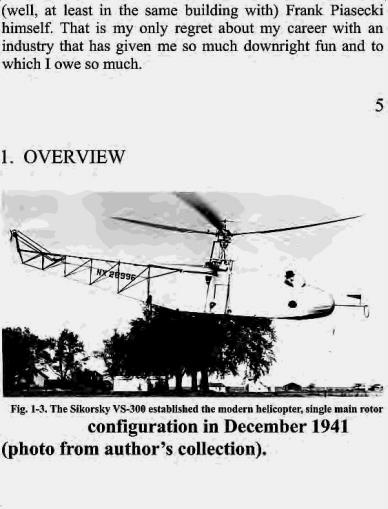
(well,at least in the same building with)Frank Piasecki himself.That is my only regret about my career with an industry that has given me so much downright fun and to which I owe so much. 5 1.OVERVIEW Fig.1-3.The Sikorsky VS-300 established the modern helicopter,single main rotor configuration in December 1941 (photo from author's collection)
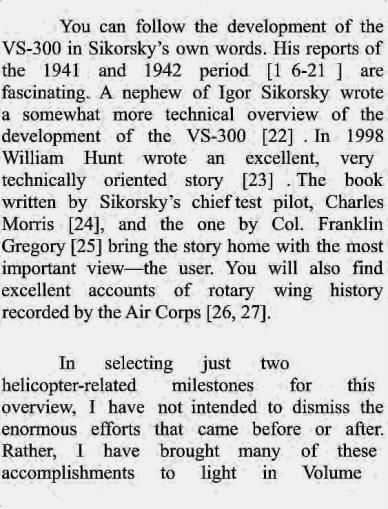
You can follow the development of the VS-300 in Sikorsky's own words.His reports of the 1941 and 1942 period [1 6-21 are fascinating.A nephew of Igor Sikorsky wrote a somewhat more technical overview of the development of the VS-300 [22].In 1998 William Hunt wrote an excellent,very technically oriented story [23].The book written by Sikorsky's chief test pilot,Charles Morris [24],and the one by Col.Franklin Gregory [25]bring the story home with the most important view-the user.You will also find excellent accounts of rotary wing history recorded by the Air Corps [26,27] In selecting just two helicopter-related milestones for this overview,I have not intended to dismiss the enormous efforts that came before or after. Rather,I have brought many of these accomplishments to light in Volume
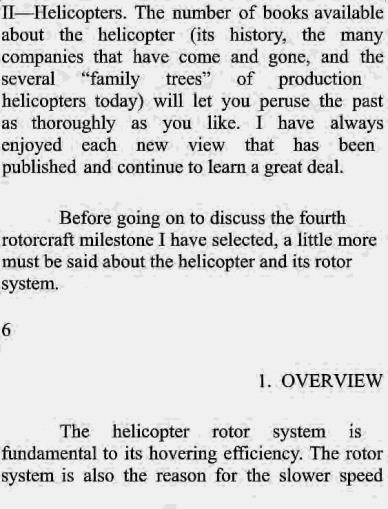
II-Helicopters.The number of books available about the helicopter (its history,the many companies that have come and gone,and the several“family trees'”'of production helicopters today)will let you peruse the past as thoroughly as you like.I have always enjoyed each new view that has been published and continue to learn a great deal. Before going on to discuss the fourth rotorcraft milestone I have selected,a little more must be said about the helicopter and its rotor system. 6 1.OVERVIEW The helicopter rotor system is fundamental to its hovering efficiency.The rotor system is also the reason for the slower speed
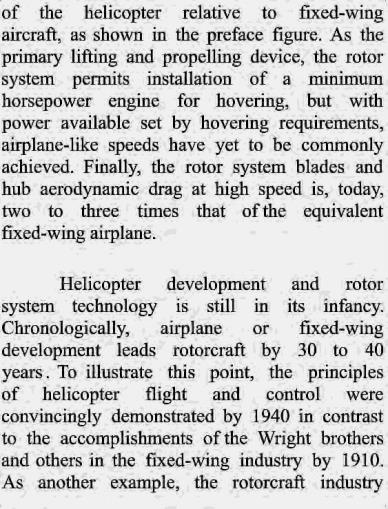
of the helicopter relative to fixed-wing aircraft,as shown in the preface figure.As the primary lifting and propelling device,the rotor system permits installation of a minimum horsepower engine for hovering,but with power available set by hovering requirements, airplane-like speeds have yet to be commonly achieved.Finally,the rotor system blades and hub aerodynamic drag at high speed is,today, two to three times that of the equivalent fixed-wing airplane. Helicopter development and rotor system technology is still in its infancy. Chronologically,airplane or fixed-wing development leads rotorcraft by 30 to 40 years.To illustrate this point,the principles of helicopter flight and control were convincingly demonstrated by 1940 in contrast to the accomplishments of the Wright brothers and others in the fixed-wing industry by 1910. As another example,the rotorcraft industry
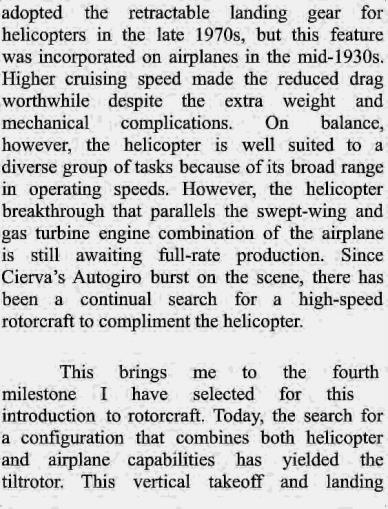
adopted the retractable landing gear for helicopters in the late 1970s,but this feature was incorporated on airplanes in the mid-1930s Higher cruising speed made the reduced drag worthwhile despite the extra weight and mechanical complications.On balance, however,the helicopter is well suited to a diverse group of tasks because of its broad range in operating speeds.However,the helicopter breakthrough that parallels the swept-wing and gas turbine engine combination of the airplane is still awaiting full-rate production.Since Cierva's Autogiro burst on the scene,there has been a continual search for a high-speed rotorcraft to compliment the helicopter. This brings me to the fourth milestone I have selected for this introduction to rotorcraft.Today,the search for a configuration that combines both helicopter and airplane capabilities has s yielded the tiltrotor.This vertical takeoff and landing